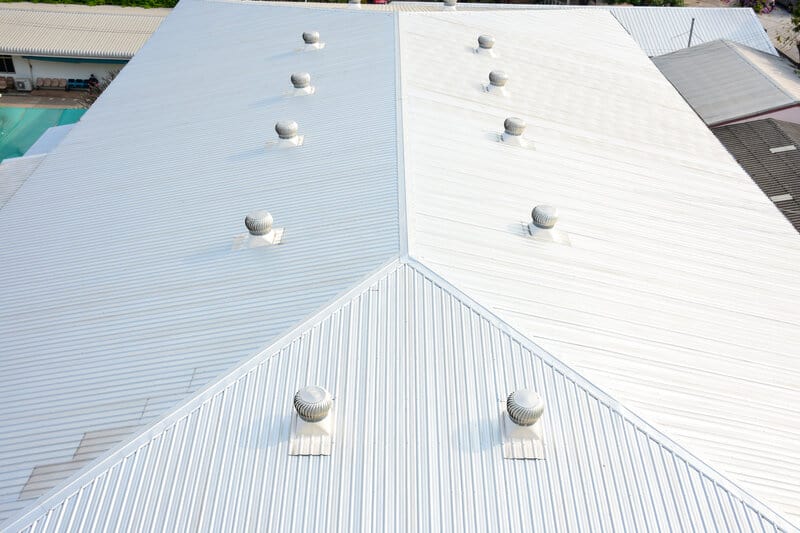
Outdated roofs pose significant problems for commercial building owners. First, there’s the safety of your employees and customers, as any cave-ins or structural issues related to the old roof threaten their well-being.
However, a commercial roof needing replacement also threatens structural wall integrity, not to mention the business’s equipment, supplies, furniture, technology, and anything else housed inside the building.
Commercial Buildings Say It’s Time For A Replacement When…
There are clear indicators or signs it’s time to replace a commercial roof. Some of the most telling are:
You haven’t replaced the roof in 20 years or more
The age of the roof is one of the most telling indicators of whether you’re due for a roof replacement. Most roofs should last about 25 years or so, after which it’s time to consider replacing them. The exception to that would be a high-quality metal roof, which can last for 40 years or more.
However, the quality of roofing materials matters. If you purchased or inherited a commercial building that has a metal roof, have it inspected by a licensed roofer to verify its status. If it was installed 25 or more years ago, it might not be the quality of a metal roof designed to last for half a century.
The leaks return as fast as they are repaired
Sometimes, roofs leak despite being well-constructed and maintained. High wind speeds, driving rain, or pooling water are some of the biggest instigators of commercial roof leaks. Worth noting is that many commercial or industrial-style buildings have flat roofs, which are far more prone to leaking if water can’t drain properly.
However, the older your roof is, the more likely it is to leak. If you keep using patch-style roof repairs and the roof continues developing leaks, it’s probably time to think about replacing it.
Signs of roof damage (or loose roofing materials) during an inspection
Your commercial building should have a roof inspection at least once every year. The roofing contractor will suggest a roof replacement for an older or poorly maintained roof if they notice:
- Damaged flashing.
- Sagging or sponginess in the roof (evidence of water and/or structural damage).
- Significantly cracked, missing, or loose roofing materials.
- Other signs of compromised roofing materials that aren’t worth replacing.
We may also notice branches or debris deposited on the building during the previous storm, which is a sign that landscaping may need attention.
While a roof repair may seem more affordable than replacement in the immediate moment, roofers don’t lie about needing a roof replacement. They know that patching a roof needing replacement costs customers far more in the long run and we want to help you avoid that.
Note: Scheduling an annual inspection from a local licensed roofing contractor is the best way to optimize the outcome of insurance claims you need to file.
Rising energy consumption (especially during peak heat/cold seasons)
There are several reasons for escalating energy consumption. Compare previous years’ energy consumption (rather than spending, although that’s also a factor). If your building uses more energy to heat and cool the building, an old or poorly maintained roof could be the issue.
Energy efficiency is a priority for most Bay Area business owners, so it’s time to get to the heart of the matter. If your HVAC contractor has already given you the all-clear, the roof may be the culprit. Old roofs are responsible for heat absorption and loss that cause the HVAC to work overtime to maintain the desired thermostat settings.
Moisture control issues
Several things play a role in moisture control. The roof is one of them. An old or leaky roof, or one that is poorly ventilated, contributes to interior humidity issues. If the problem isn’t taken care of, the building is more susceptible to mold and mildew. You may see actual signs of mold/mildew or notice a musty odor. There may be stains on the ceilings or the interior sides of the exterior walls. Spongy walls, warped or bubbling interior paint, or soft areas around windows and exterior doorways are additional signs of moisture issues.
Poor drainage when it rains
Is your roof struggling to shed water away from the building when it rains? A well-designed and installed roof keeps water far away from the building. Depending on the building’s design, we do this using slope, flashing, and gutters/downspouts.
When properly built and maintained, you should never have to walk through a sheet of water to enter or leave the building. The roof’s drainage system should carry water and small storm debris into the gutters, through the downspouts, and away from the building’s foundation. If your drainage system isn’t working properly, a roofer can tell you what’s on. Sometimes, it’s as simple as general maintenance and cleaning or replacing damaged gutters/downspouts. However, it may be that there’s a larger problem with the roof design, in which case a replacement is essential.
It’s far less expensive to shore up the roof or replace gutters and downspouts than it is to repair foundation issues caused by chronic water damage due to poor roof function.
Pacific Coast Roof Is A Trusted Bay Area Roofing Pro
The professionals at Pacific Coast Roofing have built, maintained, and repaired commercial roofs in and around the Bay Area for more than 20 years. Our small, family-run business values honesty and loyal customer relationships.
If you are experiencing some of the signs your commercial roof needs replacement or you know you’re overdue for an inspection, call us at (510) 912-5454 or schedule a free, no-obligation consultation online. We’ll take a look and let you know what we find. Our consistent A+ rating with BBB and stellar online reviews are testaments to our integrity.

